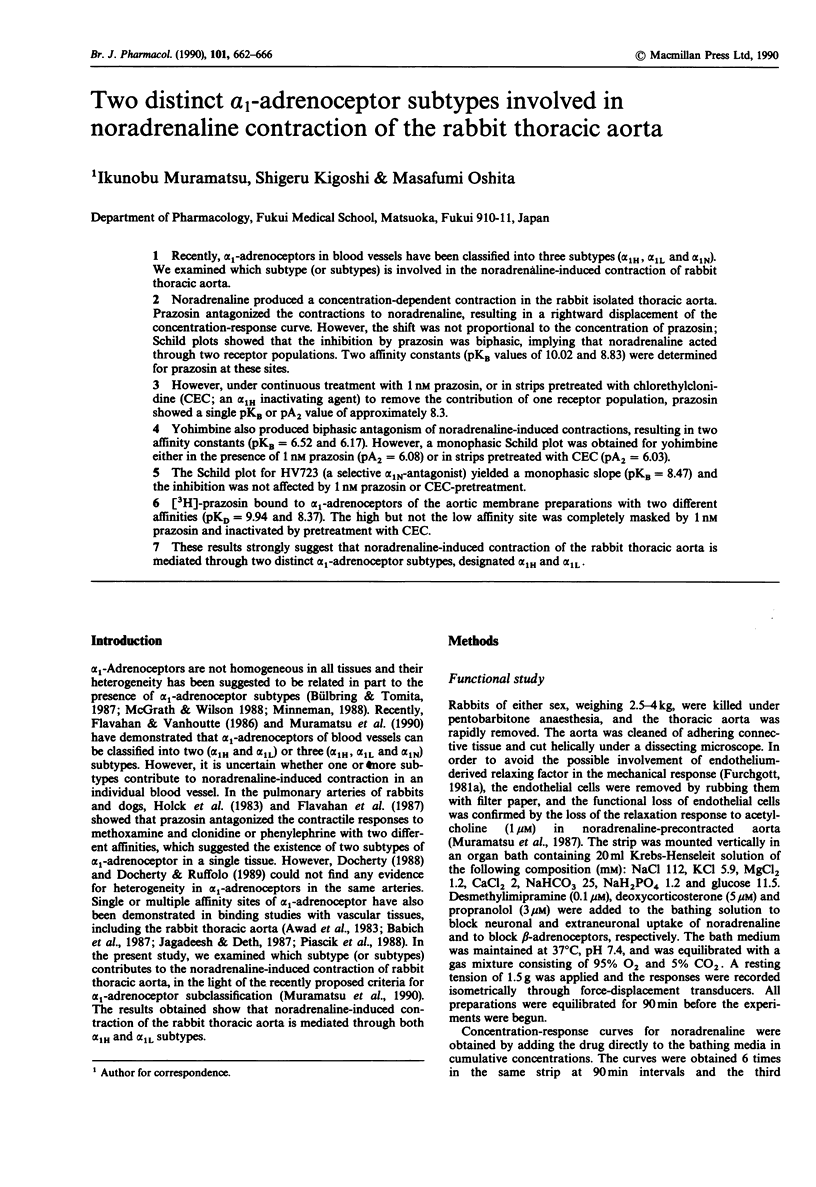Abstract
1. Recently, alpha 1-adrenoceptors in blood vessels have been classified into three subtypes (alpha 1H, alpha 1L and alpha 1N). We examined which subtype (or subtypes) is involved in the noradrenaline-induced contraction of rabbit thoracic aorta. 2. Noradrenaline produced a concentration-dependent contraction in the rabbit isolated thoracic aorta. Prazosin antagonized the contractions to noradrenaline, resulting in a rightward displacement of the concentration-response curve. However, the shift was not proportional to the concentration of prazosin; Schild plots showed that the inhibition by prazosin was biphasic, implying that noradrenaline acted through two receptor populations. Two affinity constants (pKB values of 10.02 and 8.83) were determined for prazosin at these sites. 3. However, under continuous treatment with 1 nM prazosin, or in strips pretreated with chlorethylclonidine (CEC; an alpha 1H inactivating agent) to remove the contribution of one receptor population, prazosin showed a single pKB or pA2 value of approximately 8.3. 4. Yohimbine also produced biphasic antagonism of noradrenaline-induced contractions, resulting in two affinity constants (pKB = 6.52 and 6.17). However, a monophasic Schild plot was obtained for yohimbine either in the presence of 1 nM prazosin (pA2 = 6.08) or in strips pretreated with CEC (pA2 = 6.03). 5. The Schild plot for HV723 (a selective alpha 1N-antagonist) yielded a monophasic slope (pKB = 8.47) and the inhibition was not affected by 1 nM prazosin or CEC-pretreatment. 6. [3H]-prazosin bound to alpha 1-adrenoceptors of the aortic membrane preparations with two different affinities (pKD = 9.94 and 8.37).(ABSTRACT TRUNCATED AT 250 WORDS)
Full text
PDF




Selected References
These references are in PubMed. This may not be the complete list of references from this article.
- ARUNLAKSHANA O., SCHILD H. O. Some quantitative uses of drug antagonists. Br J Pharmacol Chemother. 1959 Mar;14(1):48–58. doi: 10.1111/j.1476-5381.1959.tb00928.x. [DOI] [PMC free article] [PubMed] [Google Scholar]
- Awad R., Payne R., Deth R. C. Alpha adrenergic receptor subtype associated with receptor binding, Ca++ influx, Ca++ release and contractile events in the rabbit aorta. J Pharmacol Exp Ther. 1983 Oct;227(1):60–67. [PubMed] [Google Scholar]
- Babich M., Pedigo N. W., Butler B. T., Piascik M. T. Heterogeneity of alpha 1 receptors associated with vascular smooth muscle: evidence from functional and ligand binding studies. Life Sci. 1987 Aug 10;41(6):663–673. doi: 10.1016/0024-3205(87)90445-0. [DOI] [PubMed] [Google Scholar]
- Bülbring E., Tomita T. Catecholamine action on smooth muscle. Pharmacol Rev. 1987 Mar;39(1):49–96. [PubMed] [Google Scholar]
- Docherty J. R. No evidence for more than one type of alpha 1-adrenoreceptor in rabbit pulmonary artery. J Auton Pharmacol. 1988 Dec;8(4):327–332. doi: 10.1111/j.1474-8673.1988.tb00576.x. [DOI] [PubMed] [Google Scholar]
- Docherty J. R., Ruffolo R. R., Jr Canine pulmonary artery contains a homogeneous population of alpha-1 adrenoceptors. J Pharmacol Exp Ther. 1989 Feb;248(2):479–483. [PubMed] [Google Scholar]
- Han C., Abel P. W., Minneman K. P. Heterogeneity of alpha 1-adrenergic receptors revealed by chlorethylclonidine. Mol Pharmacol. 1987 Oct;32(4):505–510. [PubMed] [Google Scholar]
- Hanft G., Gross G. Subclassification of alpha 1-adrenoceptor recognition sites by urapidil derivatives and other selective antagonists. Br J Pharmacol. 1989 Jul;97(3):691–700. doi: 10.1111/j.1476-5381.1989.tb12005.x. [DOI] [PMC free article] [PubMed] [Google Scholar]
- Holck M. I., Jones C. H., Haeusler G. Differential interactions of clonidine and methoxamine with the postsynaptic alpha-adrenoceptor of rabbit main pulmonary artery. J Cardiovasc Pharmacol. 1983 Mar-Apr;5(2):240–248. doi: 10.1097/00005344-198303000-00013. [DOI] [PubMed] [Google Scholar]
- Jagadeesh G., Deth R. C. Different affinity states of alpha-1 adrenergic receptors defined by agonists and antagonists in bovine aorta plasma membranes. J Pharmacol Exp Ther. 1987 Nov;243(2):430–436. [PubMed] [Google Scholar]
- Kenakin T. P. The classification of drugs and drug receptors in isolated tissues. Pharmacol Rev. 1984 Sep;36(3):165–222. [PubMed] [Google Scholar]
- Leclerc G., Rouot B., Schwartz J., Velly J., Wermuth C. G. Studies on some para-substituted clonidine derivatives that exhibit an alpha-adrenoceptor stimulant activity. Br J Pharmacol. 1980;71(1):5–9. doi: 10.1111/j.1476-5381.1980.tb10902.x. [DOI] [PMC free article] [PubMed] [Google Scholar]
- McGrath J., Wilson V. Alpha-adrenoceptor subclassification by classical and response-related methods: same question, different answers. Trends Pharmacol Sci. 1988 May;9(5):162–165. doi: 10.1016/0165-6147(88)90030-2. [DOI] [PubMed] [Google Scholar]
- Milnor W. R. Limitations of Schild plots in a two-receptor system: alpha adrenoceptors of vascular smooth muscle. J Pharmacol Exp Ther. 1986 Jul;238(1):237–241. [PubMed] [Google Scholar]
- Minneman K. P. Alpha 1-adrenergic receptor subtypes, inositol phosphates, and sources of cell Ca2+. Pharmacol Rev. 1988 Jun;40(2):87–119. [PubMed] [Google Scholar]
- Morrow A. L., Creese I. Characterization of alpha 1-adrenergic receptor subtypes in rat brain: a reevaluation of [3H]WB4104 and [3H]prazosin binding. Mol Pharmacol. 1986 Apr;29(4):321–330. [PubMed] [Google Scholar]
- Munson P. J., Rodbard D. Ligand: a versatile computerized approach for characterization of ligand-binding systems. Anal Biochem. 1980 Sep 1;107(1):220–239. doi: 10.1016/0003-2697(80)90515-1. [DOI] [PubMed] [Google Scholar]
- Muramatsu I., Ohmura T., Kigoshi S., Hashimoto S., Oshita M. Pharmacological subclassification of alpha 1-adrenoceptors in vascular smooth muscle. Br J Pharmacol. 1990 Jan;99(1):197–201. doi: 10.1111/j.1476-5381.1990.tb14678.x. [DOI] [PMC free article] [PubMed] [Google Scholar]
- Muramatsu I. The effect of reserpine on sympathetic, purinergic neurotransmission in the isolated mesenteric artery of the dog: a pharmacological study. Br J Pharmacol. 1987 Jul;91(3):467–474. doi: 10.1111/j.1476-5381.1987.tb11238.x. [DOI] [PMC free article] [PubMed] [Google Scholar]
- Piascik M. T., Kusiak J. W., Pitha J., Butler B. T., Le H. T., Babich M. Alkylation of alpha-1 receptors with a chemically reactive analog of prazosin reveals low affinity sites for norepinephrine in rabbit aorta. J Pharmacol Exp Ther. 1988 Sep;246(3):1001–1011. [PubMed] [Google Scholar]


